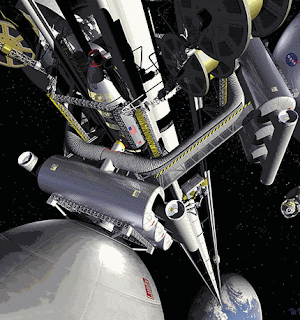Figure 1. The space elevator, supported against gravity by centrifugal force, could forge a versatile link between the surface of Earth and the reaches of outer space. To realize the concept, we will need to manufacture new, strong materials, almost certainly designed with the help of computers. (Rendition by Pat Rawlings, courtesy of NASA.)
Citation: Phys. Today 69, 4, 32 (2016); http://dx.doi.org/10.1063/PT.3.3137
Topics: Futurism, Materials Science, Physics, Science Fiction, Space Exploration
Arthur C. Clarke proposed the concept in "The Fountains of Paradise" when I was a senior in high school. He also gave us the geosynchronous orbit, also known by the name: Clarke Orbit. I titled this one hundred years into the future following the premise of "Fountains," though we may master the technology sooner. Either would be fine with me: one I might just get to see. The other humanity might survive themselves, and colonize first Mars to engineer habitats in a clearly hostile environment; the Asteroid Belt for building materials; several choice moons for water beneath their icy crusts, eventually to the stars, the "stuff" we're all made of, compelled by its call to return.
“The nitrogen in our DNA, the calcium in our teeth, the iron in our blood, the carbon in our apple pies were made in the interiors of collapsing stars. We are made of starstuff.” Carl Sagan, Cosmos
The fundamental questions of the future will be profound, sophisticated, and difficult to answer. And the great projects of the future will be grand indeed.
What will the next 100 years in physics bring? I don’t know, of course, but it is a mind-expanding question to contemplate. The considered guesses recorded here naturally reflect my own interests, knowledge, limitations, and prejudices. And to keep this article within acceptable size, I’ve had to be crazily selective in choosing what to include. Its conjectures will have served their purpose if they provoke you to think about the question yourself, even if in the end you answer it quite differently (see the announcement on page 36).
To gain perspective, let us look back before looking ahead.
A century ago physics was in turmoil. Albert Einstein had only just published his revolutionary new theory of gravity. Ernest Rutherford’s recently discovered atomic nuclei, at the heart of matter, were mysterious, almost bizarre objects—terribly small, terribly dense, and subject to a bewildering variety of causeless transformations. Quantum theory, which featured Niels Bohr’s atomic model, was a tissue of guesswork. Superconductivity was an empirical fact, but a theoretical enigma. The nature of the chemical bond and the energy source of stars—supremely important aspects of the natural world—embarrassed contemporary physics.
Fifty years ago the picture had become quite different. General relativity was an established subject with a vast literature and a handful of experimental applications. Together with Edwin Hubble’s discovery of the expanding universe, it had opened new possibilities for scientific cosmology. The recently discovered microwave background radiation, together with a successful semiquantitative theory of cosmic nucleogenesis, pointed clearly to the Big Bang. Quantum mechanics was a mathematically precise, consistent, and wildly successful theory, though it seemed strange and troubling to many. It had become, as it remains, the language through which we speak with nature.
Physics Today: Physics in 100 years, Frank Wilczek

Comments